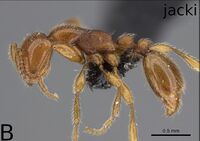Aenictus jacki
| Aenictus jacki | |
|---|---|

| |
| Scientific classification | |
| Kingdom: | Animalia |
| Phylum: | Arthropoda |
| Class: | Insecta |
| Order: | Hymenoptera |
| Family: | Formicidae |
| Subfamily: | Dorylinae |
| Genus: | Aenictus |
| Species group: | rotundatus |
| Species complex: | rotundatus |
| Species: | A. jacki |
| Binomial name | |
| Aenictus jacki Gomez, 2022 | |
Known from the type series, a collection from the soil of a riparian moist-forest in Gorongosa National Park, Mozambique.
Identification
Gómez (2022) - A member of the rotundatus species complex in the Aenictus rotundatus species group. Identification of A. jacki is quite straightforward in the rotundatus group due to its abundant reclined white setae. Only Aenictus congolensis presents adpressed setae, but they are separable due to the much shorter scapes (SIL<61 for A. jacki, SIL>68 for A. congolensis), the much sparser pilosity, more developed propodeal ridge and digitiform shape of subpetiolar process in A. congolensis.
Keys including this Species
Distribution
Latitudinal Distribution Pattern
Latitudinal Range: -19° to -19°.
| North Temperate |
North Subtropical |
Tropical | South Subtropical |
South Temperate |
- Source: Gomez, 2022
Distribution based on Regional Taxon Lists
Afrotropical Region: Mozambique (type locality).
Distribution based on AntMaps
Distribution based on AntWeb specimens
Check data from AntWeb
Countries Occupied
| Number of countries occupied by this species based on AntWiki Regional Taxon Lists. In general, fewer countries occupied indicates a narrower range, while more countries indicates a more widespread species. |

|
Estimated Abundance
| Relative abundance based on number of AntMaps records per species (this species within the purple bar). Fewer records (to the left) indicates a less abundant/encountered species while more records (to the right) indicates more abundant/encountered species. |

|
Biology
Castes
Known from the worker caste. Table of castes known for all Afrotropical Aenictus species.
Nomenclature
The following information is derived from Barry Bolton's Online Catalogue of the Ants of the World.
- jacki. Aenictus jacki Gómez, 2022: 68, figs. 52A-D, 53 (w.) MOZAMBIQUE.
- Type-material: holotype worker, 9 paratype workers.
- Type-locality: holotype Mozambique: Sofala, 3 km. SE Chitengo, Gorongosa Nat. Park, 40 m., 19.00352, 34.37811, riparian moist forest, in soil (J. Longino); paratypes with same data.
- Type-depositories: BMNH (holotype); AFRC, BMNH, CASC, HGPC, ISNB, JTLC, KGPC, MHNG, SAMC (paratypes).
- [Note: 7 more paratypes stored in ethanol JTLC.]
- Distribution: Mozambique.
Unless otherwise noted the text for the remainder of this section is reported from the publication that includes the original description.
Description
Worker
HL: 0.57 [0.52-0.62]; HW: 0.49 [0.46-0.52]; SL: 0.34 [0.30-0.36]; WL: 0.84 [0.78-0.89]; PL: 0.21 [0.20-0.22]; PH: 0.14 [0.13-0.15]; PPL: 0.15 [0.14- 0.16]; PPH: 0.13 [0.11-0.14]; CS: 0.53 [0.49-0.57]; CI: 85 [83-88]; SIL: 59 [57-60]; SIW: 69 [66-72]; WL/HW: 171 [165-175]; PI: 144 [133-153]; PPI: 120 [107-136]; CSR: 116; (n=8).
With the characteristics of the rotundatus species complex and: scapes short, just passing the median line of the head when laid back (SL/HL~0.62). Funicular segments subquadrate, apical more than twice longer than wide. Head rectangular, longer than wide (CI~86), slightly widest at the middle. Occipital line slightly concave. Mandibles triangular with a long, sharp apical tooth, one small preapical tooth and 4–5 smaller denticles. Clypeus very reduced, with a row of very small, triangular teeth, which can be very eroded and difficult to discern when mandibles closed. Frontal ridges present, fused between the antennal sockets.
Pronotum slightly convex, with the mesopropodeal suture very weak, concave, meeting the flat propodeum at an angle. This with a very reduced but discernible anterior slope and elevated over the mesonotum. Transverse mesopleural groove present and discernible as a darker line at its first anterior half. Mesometapleural suture present but weak. Propodeal declivity vertical and flat; propodeal ridge absent.
Petiole sessile with anterolateral ridges present, anterodorsal and dorsolateral ridges absent. Petiolar node rounded, anteriorly a quarter of ellipse, small flat dorsal surface and almost vertical posteriorly; postpetiolar dome quadrate in lateral view with vertical anterior and posterior faces, the first one shorter, and horizontal dorsally, with rounded angles; subpetiolar process strongly developed, with a small elliptical process followed by a big triangular lamellae oriented downwards, the lamella as big or usually larger than the rest of the process.
Mandibles smooth to patchly shagreened, sometimes with irregular small rugulae; head, scapes, pronotum, mesonotum, dorsopostpetiole, legs and gaster glassy smooth; mesopleurae and propodeum strongly reticulate, matt, with some short horizontal and incomplete rugulae laterally; petiole and lateroposteptiole alutaceus to reticulated. Overall colour light brown, punctate zones and sutures darker.
Sides of head and mandibles with semierect to erect setae; rest of the head, except vertex, with decumbent to adpressed setae oriented outwards; vertex and surroundings to the occiput with slightly longer decumbent to semierect setae, oriented to the midline, creating a small dome; scapes with unequal decumbent to semierect setae, the longest longer than scape width; dorsal surfaces of pronotum, metanotum, petiole and postpetiole as well as the whole gaster densely covered with very abundant, semierect to reclinate setae, similar in length and shorter than propodeum height; most of the setae bent to the horizontal and pointing backwards; dorsopropodeum bare, posteropropodeum with scattered erect setae. Legs covered with semierect setae, shorter than maximum tibiae width; all setae white. No pubescence noted.
Type Material
- Holotype worker: MOZAMBIQUE: • Sofala, 3 km SE Chitengo, Gorongosa Nat. Park 40 m, -19.00352, 34.37811; search (J. Longino); riparian moist forest (1w), in soil [JTL761548A02] The Natural History Museum.
- Paratype workers: • same series (1w) [CASENT0840034] FHGC; (1w) [CASENT0840036] CASC; (1w) [CASENT0840037] MHNG; (1w) [CASENT0840038] RBINS; (1w) [CASENT0840039] KGPC; (1w) [CASENT0840040] AFRC; (1w) [CASENT0840041] BMNH; (1w) [CASENT0840042] JTLC; (1w) [CASENT0840042] SAMC; (7w in ethanol) [JTL761548] JTLC.
Etymology
The species name jacki is Latinized noun in the genitive case, dedicated to Dr. John Longino, who kindly sent me the material.

